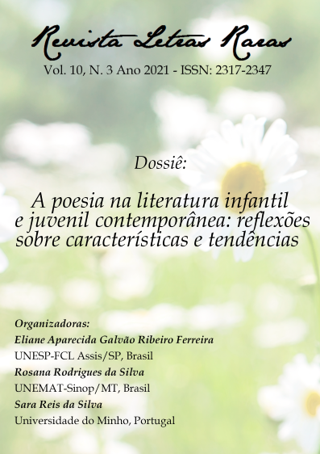Between reason and passion: the Ovidian myth of Pyramus and Thisbe revisited in Shakespeare’s Romeo and Juliet
DOI:
https://doi.org/10.5281/zenodo.10058964Palavras-chave:
Pyramus and Thisbe, Romeo and Juliet, The Stoicism of Seneca, Affectus, TragedyResumo
This work aims to analyze two literary works: Romeo and Juliet by William Shakespeare and the myth of Pyramus and Thisbe, present in Book IV of The Metamorphoses, by the Latin poet Ovid. Comparing both, we investigate their tragic aspects in the light of Stoicism, according to the Latin philosopher and tragedian Seneca. The theoretical background includes Seneca, Cicero, and Brun (1986) for discussions regarding Stoicism; Aristotle, Brait (1980), and Ubersfeld (2010) for remarks concerning the character and the tragic; Bate and Rasmussen (2007) and Heliodora (2016) for discussions on Shakespeare; Closel (2011), Lucas (1922), and Lohner and Freitas (2014) to guide considerations about the Latin influence in the Elizabethan theatre. We believe that the characters responsible for moving the plots in the two works allow themselves to be influenced by affect us and, driven by passion, contrary to
reason, they make imprudent decisions that result in catastrophes. Similar catastrophes in Shakespeare and Ovid portray the consequences of the soul which allows passion to settle, setting aside its rationality. As a result of non-restraint, tragic death functions as a pedagogical resource in the action for the readers of the tragic texts in question.
Downloads
Referências
ARISTÓTELES. Poética. Tradução de Eudoro de Souza. São Paulo: Ars Poética, 1993.
Aristotle. Poetics. Aristotle in 23 Volumes, Vol. 23, translated by W.H. Fyfe. Cambridge, MA, Harvard University Press; London,1932.
BATE, Jonathan & RASMUSSEN, Eric. William Shakespeare: Complete Works. The Royal Shakespeare Company: Macmillan, 2007.
BRAIT, Beth. A Personagem. São Paulo: Ática, 1990.
BRUN, Jean. O estoicismo. São Paulo: Edições 70, 1986.
CICERO. Discussões tusculanas. Tradução Bruno Fregni Bassetto. Uberlândia: EDUFU, 2014.
CLOSEL, Régis Augustus Bars. Revisando a História da Influência de Sêneca em Shakespeare. Letrônica, v. 4, n. 1, p. 105-121, 2011.
DIÔGENES LAÊRTIOS. Vidas e doutrinas dos filósofos ilustres. Tradução, introdução e notas de Mário da Gama Kury. 2. ed., reimpressão. Brasília: Editora Universidade de Brasília, 2008.
ERNOUT, Alfred; MEILLET, Alfred. Dictionnaire Étymologique de la Langue Latine: Histoire des mots. Retirage de la 4e. édition, nouveau format. Paris: Klincksick, 2001.
GAFFIOT, F. Le Grand Gaffiot: Dictionnaire Latin Français. 30éme éd. Paris: Hachette, 2000.
HELIODORA, Bárbara. Introdução. In: SHAKESPEARE, WILLIAM. Romeu e Julieta. Tradução e introdução de Bárbara Heliodora. Rio de Janeiro: Nova Fronteira, 2016.
LOHNER, José Eduardo dos Santos; FREITAS, Renata Cazarini de. Reconhecer e traduzir traços de Sêneca em Shakespeare. Cadernos de Tradução, v. 1, n. 33, p. 287-289, 2014.
LUCAS, Frank Laurence. Seneca and Elizabethan tragedy. University Microfilms, 1922.
LUNA, Sandra. Arqueologia da Ação Trágica: o legado grego. - João Pessoa: Idéia, 2005.
OVÍDIO. Metamorfoses. Tradução, introdução e notas: Domingo Lucas Dias. São Paulo: Editora 34, 2017.
OVID, Metamorphoses. Translated by Frank Justus Miller, Loeb Classical Library, 2 vols. Cambridge, MA: Harvard University Press, v. 1, pp. 182-189, 1994.
SÊNECA. Cartas a Lucílio. Tradução J. A. Segurado e Campos. 5. ed. Lisboa: Fundação Calouste Gulbenkian, 2014.
SÊNECA. Sobre a Ira. Sobre a Tranquilidade da Alma. Tradução, introdução e notas de José Eduardo S. Lohner. São Paulo: Penguin Classics Companhia das Letras, 2014.
SENECA. The Moral Epistles. Translated by Richard Mott Gummere. In: The Complete Works of Seneca the Younger. United Kingdom: Delphi Classics, 2014.
_______. On Anger. Translated by Aubrey Stewart. In: The Complete Works of Seneca the Younger. United Kingdom: Delphi Classics, 2014.
SHAKESPEARE, WILLIAM. Romeu e Julieta. Tradução e introdução de Bárbara Heliodora. Rio de Janeiro: Nova Fronteira, 2016.
SHAKESPEARE, William. Romeo and Juliet. Ed. Cedric Watts. Hertfordshire: Wordsworth Editions Limited, 2000.
UBERSFELD, Anne. Para ler o teatro. Tradução José Simões (coord.). São Paulo: Perspectiva, 2010.
Downloads
Publicado
Como Citar
Edição
Seção
Licença
Copyright (c) 2023 Revista Letras Raras

Este trabalho está licenciado sob uma licença Creative Commons Attribution-NonCommercial 4.0 International License.







